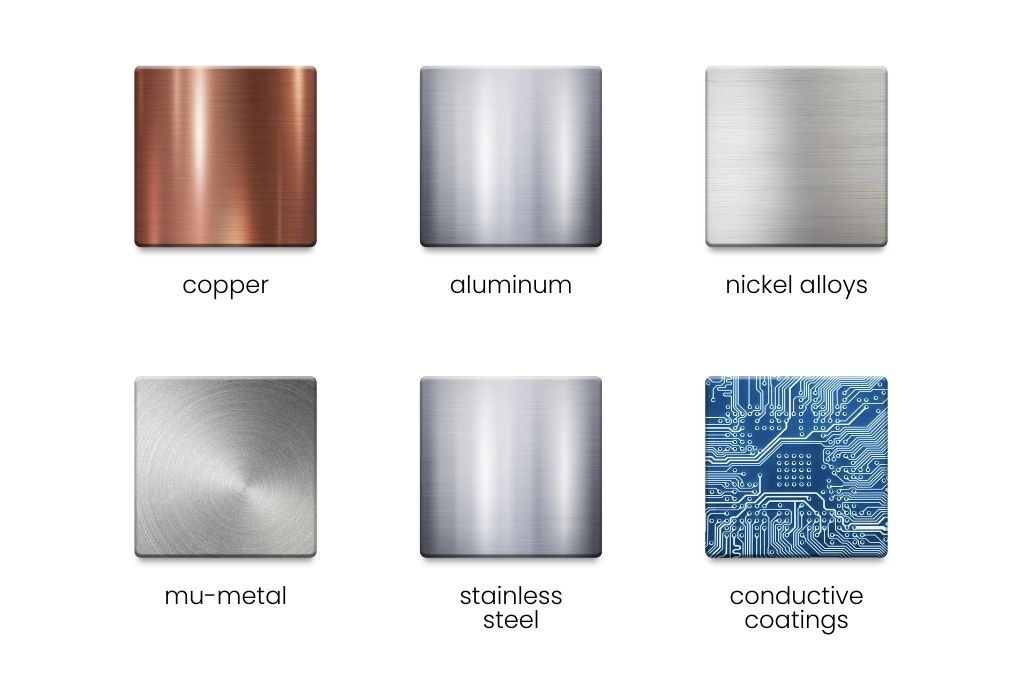E-Fab Breaks Down How to Choose the Best for Your Application
Why EMI Shielding Materials Matter
In aerospace, defense, medical, and high-performance electronics, electromagnetic interference (EMI) is absolutely mission-critical, sometimes mission-ending. Even small amounts of interference can disrupt communications, compromise navigation systems, degrade imaging clarity, or cause complete equipment failure.
Sectors such as transportation, medical, military, and critical infrastructure face a wide range of EMI threats, including both unintentional and intentional electromagnetic interference. Assessing and shielding against these EMI threats is crucial to protecting equipment and maintaining operational integrity.
Choosing the right EMI shielding materials is essential for protecting sensitive electronics, ensuring consistent performance, and meeting EMI/EMC compliance standards. The right material can mean the difference between a flawless system and one vulnerable to costly interference issues.
That’s where E-Fab combines deep material expertise with precision manufacturing to deliver optimal shielding solutions.

Quality Comes First for EMI Shielding Materials
When evaluating EMI shielding materials for your project, engineers and procurement teams should consider the following:
- Conductivity – Determines how effectively the material blocks electromagnetic interference and is a key aspect of the material’s electrical properties, which impact overall EMI shielding performance.
- Corrosion resistance – Extends service life in harsh or corrosive environments.
- Weight and mechanical properties – Important for aerospace and portable electronics.
- Cost – Balancing performance requirements with budget constraints.
- Environmental conditions – Resistance to temperature extremes, vibration, and humidity.
The effectiveness of shielding depends on application requirements, environmental conditions, and operational lifespan, all of which directly influence the selection of adequate materials.
There are many different EMI shielding materials available, each offering unique trade-offs and suitability for specific applications, which we will break down further in detail.

Copper and Copper Alloys
Pros:
- Excellent conductivity for high-frequency EMI shielding
- Certain copper alloys, such as alloy 770, resist corrosion, making them suitable for demanding environments
- Easy to form and solder
- Proven performance in electronics
Cons:
- Heavier than aluminum
- Requires coating to prevent oxidation
Copper’s high conductivity is due to its abundance of mobile electrons, which oscillate in response to incident electromagnetic waves. This movement generates opposing electromagnetic fields that reflect and attenuate external EMI, enhancing shielding effectiveness.
Best Applications: High-frequency enclosures, cable shielding, medical imaging electronics—especially effective for shielding against both magnetic and electrical waves.
Aluminum
Pros:
- Lightweight for aerospace and portable devices
- Naturally corrosion-resistant
- Cost-effective for many applications
- Aluminum is one of the most widely used conductive materials for EMI shielding
Cons:
- Lower conductivity than copper
- May need plating for optimal EMI shielding effectiveness
Best Applications: Aerospace structures, UAV electronics housings, portable defense equipment.
Aluminum acts as a conductive material, forming an effective barrier against electromagnetic interference.
Nickel and Nickel Alloys
Pros:
- Excellent in harsh environments
- Strong corrosion and oxidation resistance
- Durable under mechanical stress
- Excellent shielding effectiveness in harsh environments
Cons:
- Higher cost
- Lower conductivity than copper
Best Applications: Defense communications, marine electronics, equipment exposed to severe conditions, and protecting military equipment from electromagnetic interference.
Mu-Metal & High-Permeability Alloys
Pros:
- Exceptional for low-frequency magnetic field shielding
- Critical for magnetic interference control
- High magnetic permeability enables mu-metal to absorb and dissipate magnetic fields effectively
Cons:
- Requires careful handling
- Properties can degrade without proper annealing
Best Applications: MRI systems, aerospace magnetic sensors, precision scientific instruments. Mu-metal and similar magnetic materials are specifically engineered for shielding applications involving strong magnetic fields.
Stainless Steel
Pros:
- Strong, corrosion-resistant, and durable
- Effective against both electric and magnetic interference
- Serves as both a shielding and structural material in demanding applications
Cons:
- Heavy
- Lower conductivity than copper or aluminum
Best Applications: Defense enclosures, ruggedized medical devices, high-durability aerospace parts. Stainless steel is often used in combination with other components, such as gaskets and foils, to enhance overall EMI protection.
Conductive Coatings & Platings
Pros:
- Adds conductivity to lightweight materials
- Can be tuned for specific frequencies and corrosion resistance
- Ideal for complex geometries
- Conductive silicones and conductive elastomers can be used as coatings or gaskets to provide both electrical conductivity and EMI protection
Cons:
- Coatings can wear over time
- Added manufacturing ste
Best Applications: Aerospace connectors, medical device housings, high-frequency RF components.
Conductive fabric and EMI shielding film are often used for lightweight, flexible EMI shields in electronic devices, offering effective grounding and shielding performance. These advanced coatings and films serve as effective EMI shields for a variety of applications.
Where to Begin?
Effective EMI shielding starts with a thoughtful design process that considers the unique electromagnetic environment of your application. Selecting the right EMI shielding material, whether it’s copper alloy, pre-tin plated steel, or carbon steel, requires a careful evaluation of factors like electromagnetic radiation, electromagnetic fields, and the specific frequencies your electronic devices will encounter. The electrical conductivity and magnetic properties of each shielding material play a crucial role in determining how well it can block or redirect electromagnetic energy.
Choosing the Right EMI Shielding Material for Your Application is as Mission-Critical as the Hardware it’s Protecting
- Aerospace: Lightweight aluminum or plated aluminum alloys for vibration resistance and weight savings, often combined with EMI gaskets and electronic enclosures to ensure comprehensive electromagnetic and environmental protection.
- Medical Devices: Biocompatible materials like stainless steel or coated copper for compliance and performance.
- Defense: Nickel alloys, stainless steel, or Mu-Metal for durability and multi-frequency shielding in demanding conditions. Faraday cage principles are frequent
Manufacturing Challenges? Of course, that’s why you leave it to E-Fab’s Experts
Designing and implementing effective EMI shielding comes with its own set of challenges. We want to stress that one of the most common is selecting the optimal EMI shielding material, balancing factors like magnetic properties, electrical conductivity, and corrosion resistance to meet both technical and budgetary requirements. Accommodating a variety of electronic components, including wireless and Bluetooth devices, adds another layer of complexity, especially when dealing with conducted EMI.
Specialized techniques like tin plating can help address these challenges, offering improved shielding effectiveness and durability. Understanding the principles of electromagnetic shielding, such as the reflection method, allows engineers to optimize shield design for maximum protection. By proactively addressing these common hurdles, you can develop EMI shielding solutions that ensure the reliability and performance of your electronic devices, even in demanding environments.
Material thickness is another key factor, as it directly influences shielding effectiveness. Thicker materials often provide better attenuation of electromagnetic waves, but must be balanced against weight and space constraints. Once the design is finalized, rigorous testing is essential. This typically involves measuring how much electromagnetic interference the EMI shield can attenuate across relevant frequencies, ensuring the solution meets both industry standards and your project’s requirements. By prioritizing both design and testing, you can ensure your electronic equipment is protected by a robust, reliable EMI shielding solution.
Quick-Reference: EMI Shielding Materials by Industry
|
Material
|
Best Industries
|
Key Strengths
|
Limitations
|
|---|---|---|---|
|
Copper |
Electronics, Medical, EMI enclosures |
High conductivity, effective against radio frequency, radio frequency interference, and radio waves |
Heavy, oxidation |
|
Aluminum |
Aerospace, Consumer, EMI enclosures |
Lightweight, corrosion-resistant, good for blocking radio frequency and electrical waves |
Lower conductivity |
|
Nickel Alloys |
Defense, Marine |
Harsh environment durability, suitable for EMI enclosures |
Cost |
|
Mu-Metal |
Medical Imaging, Aerospace Sensors |
Low-frequency magnetic shielding, blocks electrical waves |
Handling sensitivity |
|
Stainless Steel |
Defense, Medical |
Strength, corrosion resistance, used in EMI enclosures |
Weight |
|
Conductive Coatings |
Aerospace, Medical |
Lightweight + conductivity, can shield against radio frequency interference |
Wear over time |
E-Fab’s Experience in EMI Shielding Materials
At E-Fab, we do more than just supply EMI shielding materials; we engineer them into high-performance shielding solutions. Our capabilities include:
- Custom photochemical etching and forming for complex geometries
- Material sourcing and selection guidance based on your application’s unique demands
- Stringent quality control for aerospace, defense, and medical compliance standards
We understand that EMI shielding materials are only as effective as the precision with which they’re fabricated. That’s why our engineering team works directly with customers from concept to production.
Protect Your Electronics with the Right EMI Shielding Materials Partner
The wrong choice of EMI shielding materials can compromise performance, compliance, and mission success. With E-Fab, you get industry-leading expertise, advanced manufacturing capabilities, and the best value for your project’s requirements. This is all backed by our rigorous and strict quality management systems.
Let’s create the optimal EMI shielding solution for your application.
Contact E-Fab today for a consultation if you still need help with your design, or if you are ready to get your project kicked off, all you need to do is submit your RFQ.
